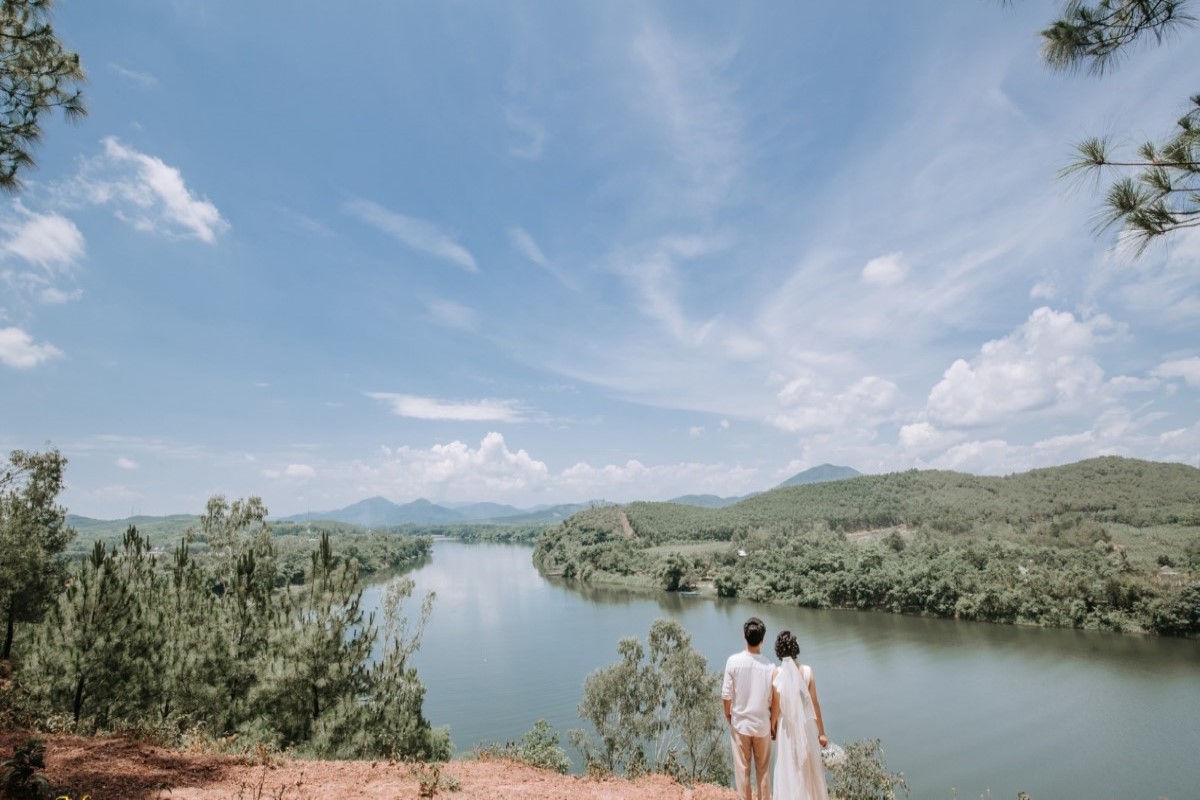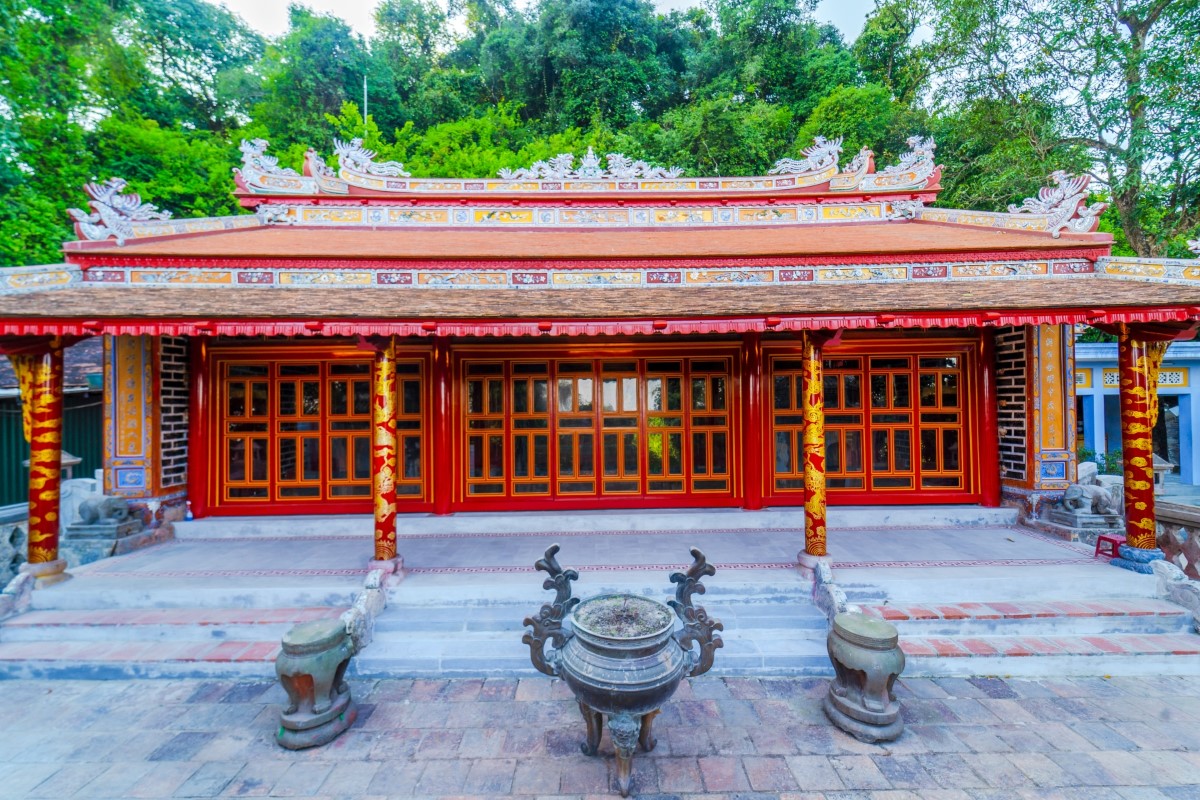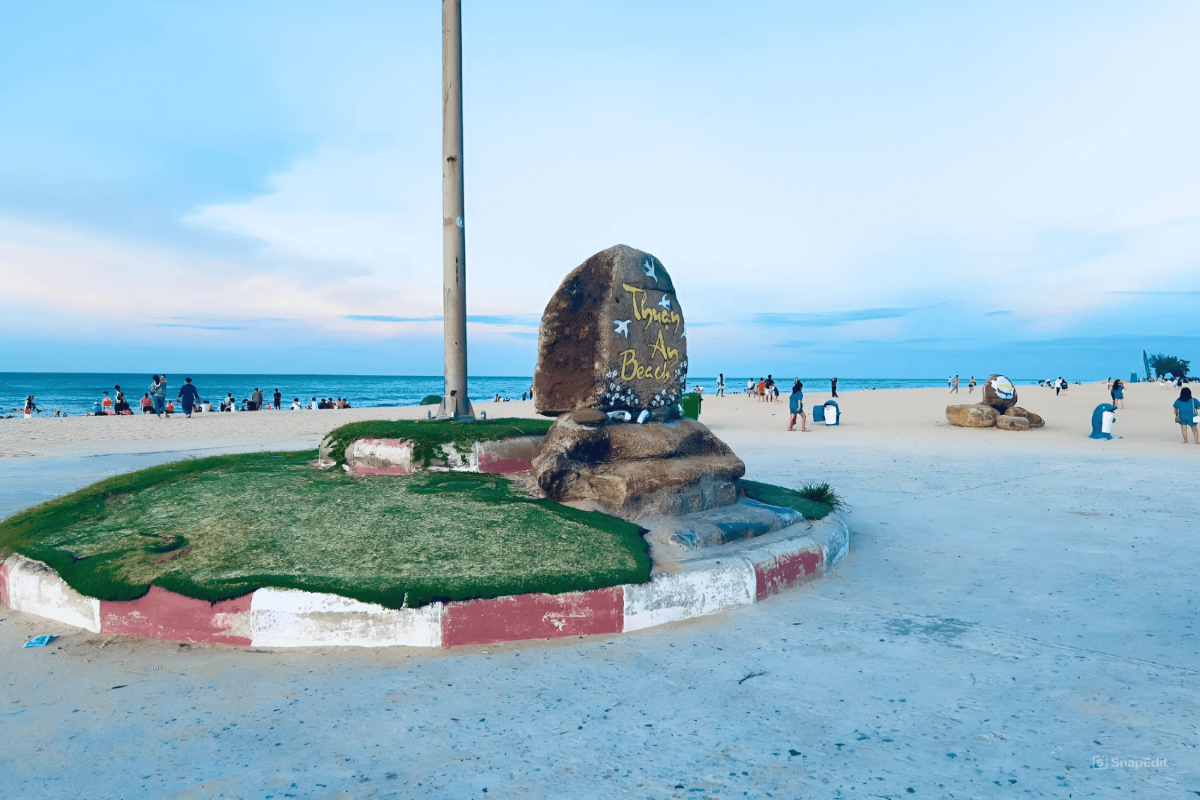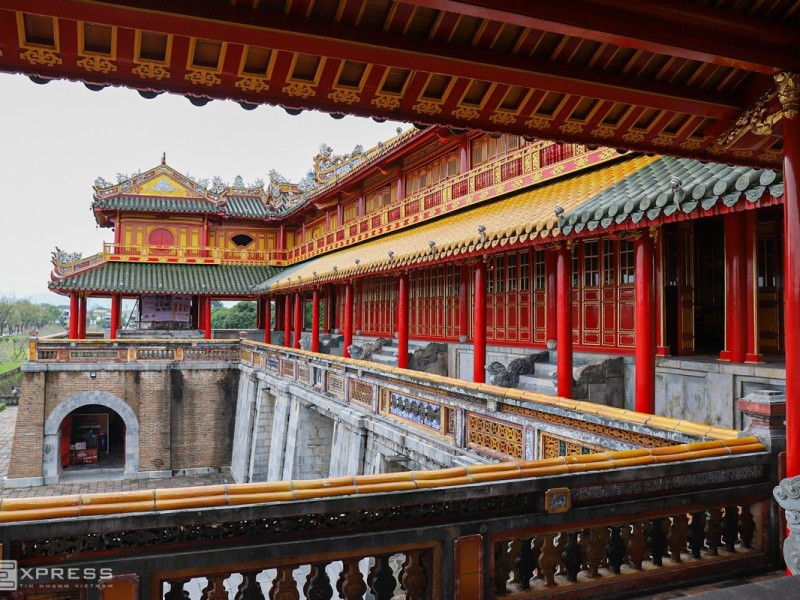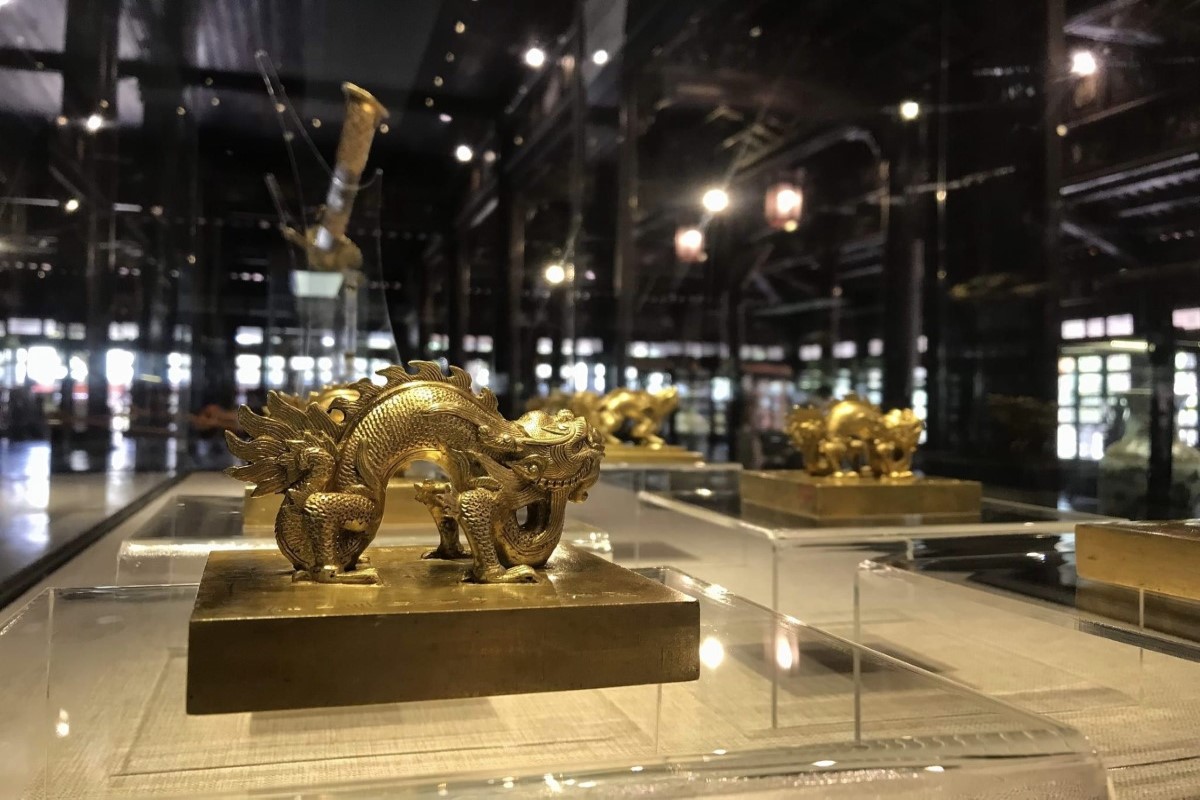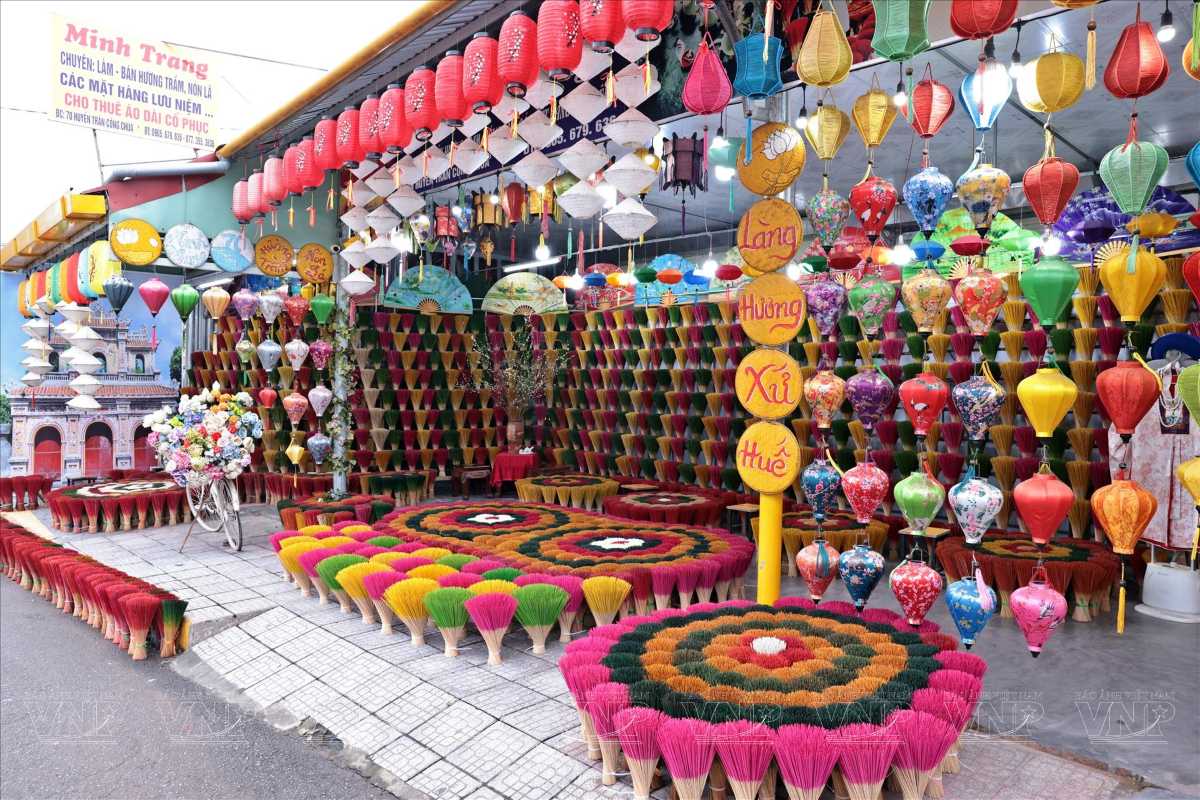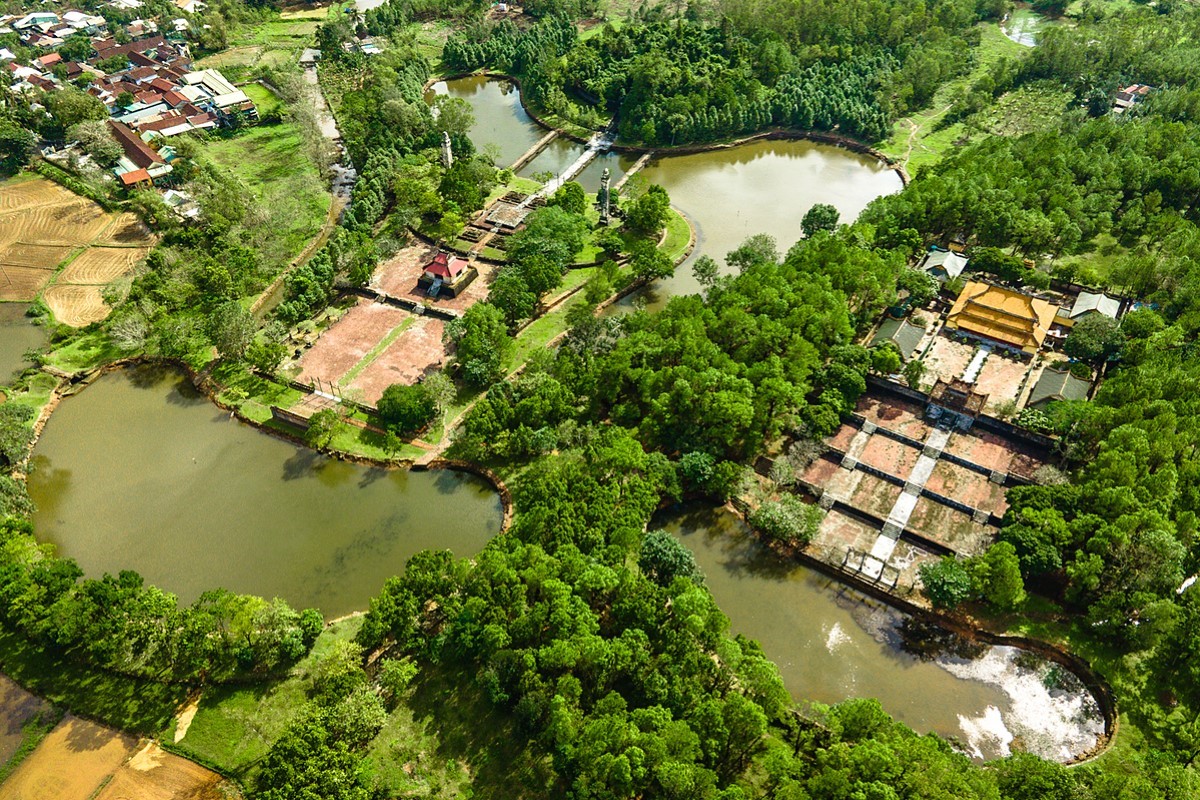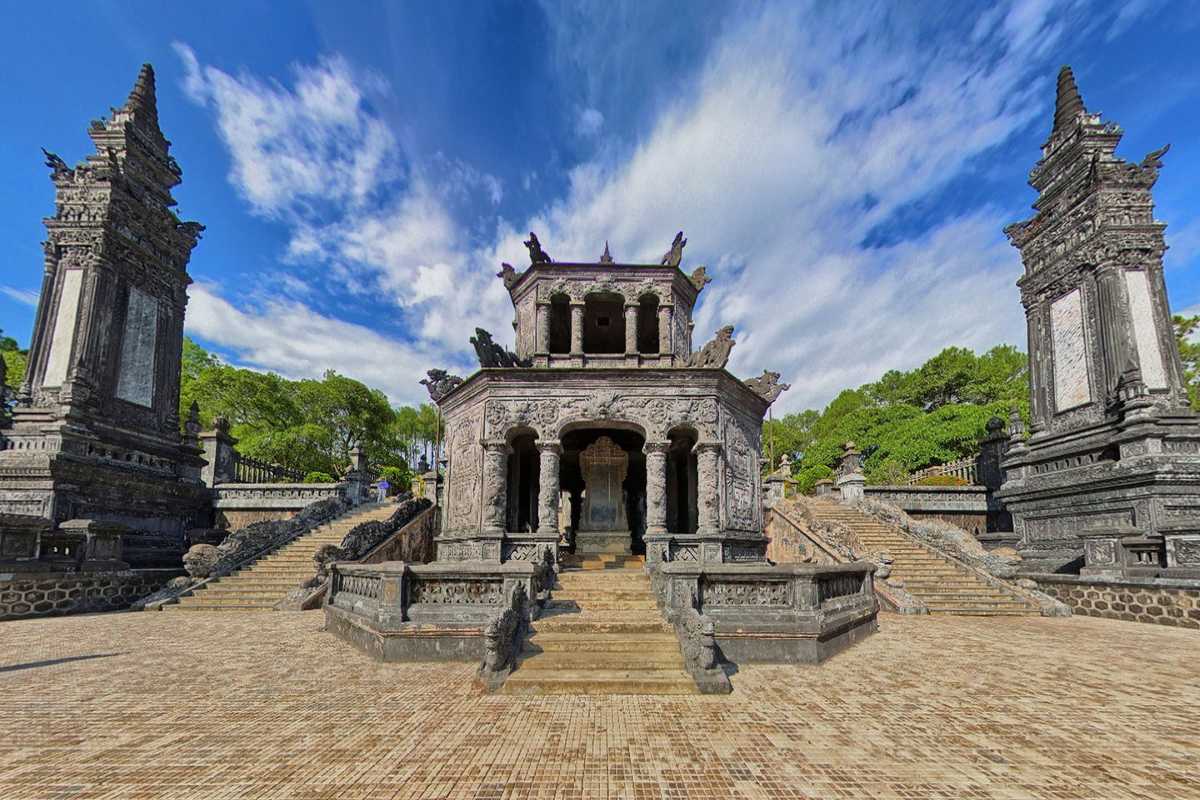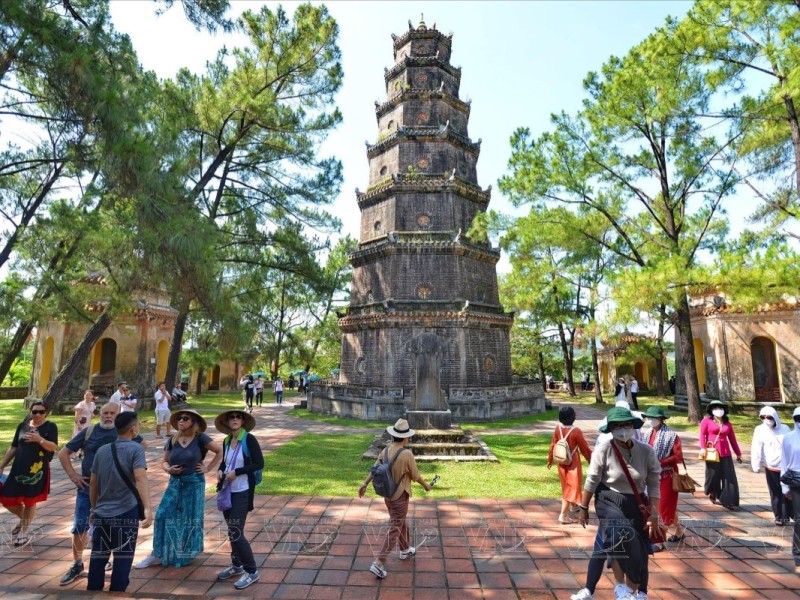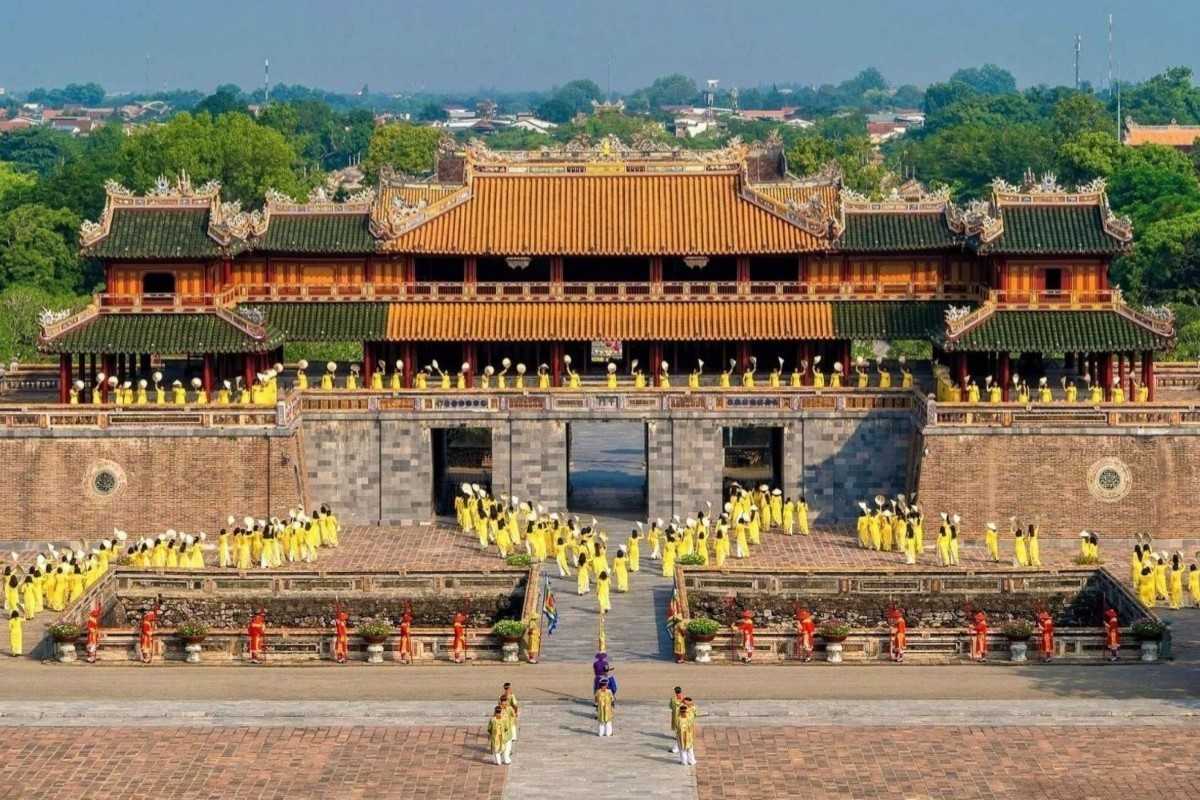Hue’s Tiger Arena: History, Battles, and Cultural Significance
Hue’s Tiger Arena is a historic site in central Vietnam where royal elephant-tiger battles once showcased the power of the Nguyễn dynasty. The arena features unique circular architecture and stands out as a rare symbol of imperial strength, offering visitors a glimpse into Vietnam’s dramatic royal traditions.
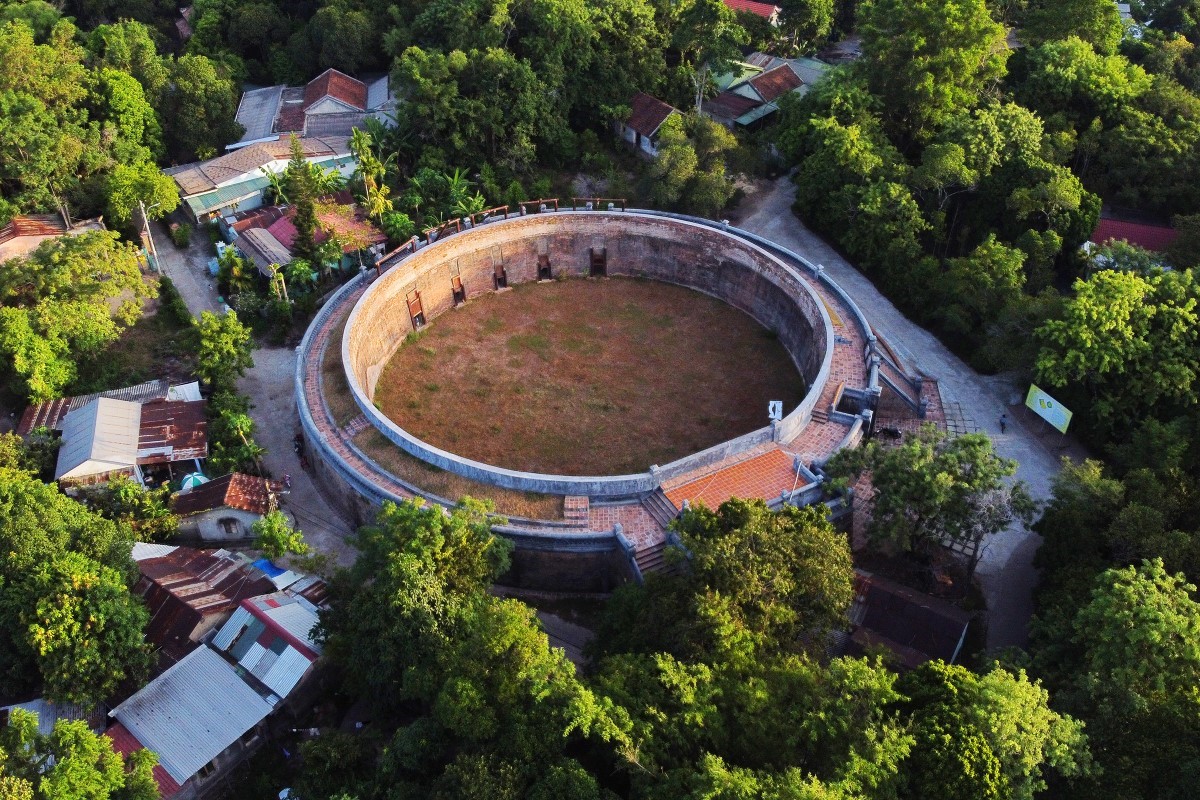
Introduction to Hue’s Tiger Arena:
Hue’s Tiger Arena (Hổ Quyền) stands as one of Vietnam's hidden historical treasures, dating back to the 19th century. Built during the reign of the Nguyễn dynasty, this imposing structure was the setting for dramatic royal elephant-tiger battles, symbolizing the emperor's command over nature and rebellion. The arena was not just a spectacle for the court; it represented power, control, and the might of the empire. Though lesser-known compared to other landmarks, this arena is a must-visit for anyone looking to delve deeper into Hue’s royal heritage.
Stepping into this historic site, visitors are transported to a time when emperors wielded immense power, using battles between mighty elephants and ferocious tigers as a display of their strength. Hue’s Tiger Arena is not just a relic of Vietnam’s past; it offers a glimpse into the cultural significance and imperial traditions that once shaped this nation. Through its well-preserved structure and the echoes of royal grandeur, the arena invites travelers to experience a unique chapter of Vietnam’s history.
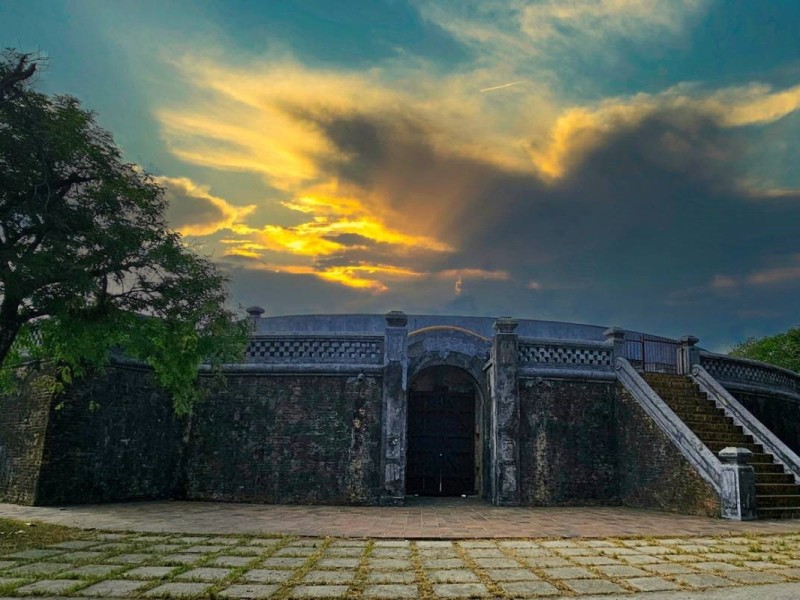
The Fascinating History of Hue’s Tiger Arena:
Hue’s Tiger Arena is steeped in history and tradition, serving as a vital part of the Nguyễn dynasty’s royal entertainment. It was constructed in 1830 under Emperor Minh Mang, specifically to host the annual elephant-tiger battles. These battles were more than just entertainment—they were a symbol of the emperor’s authority over chaotic and rebellious forces, represented by the tigers, while the elephants embodied loyalty, strength, and order.
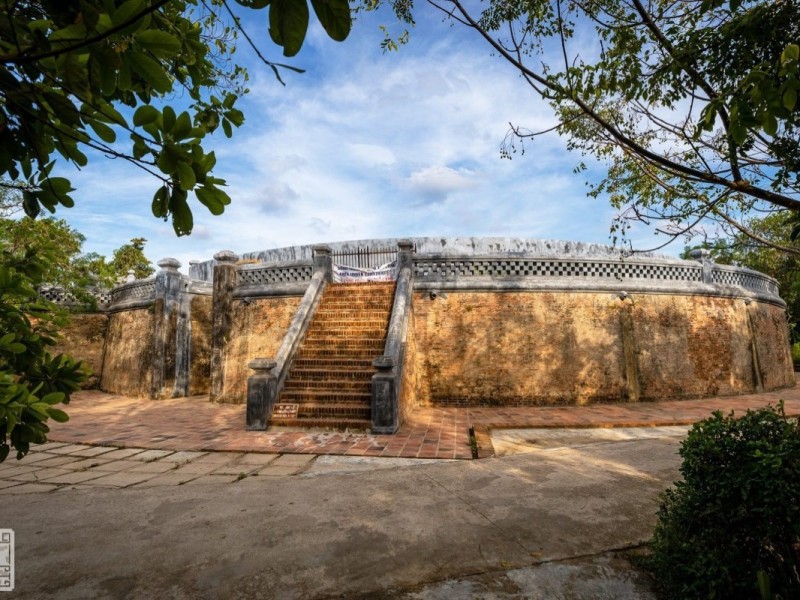
Famous Royal Figures and Their Role in the Arena’s History:
Throughout the Nguyễn dynasty, several emperors played crucial roles in shaping the tradition of these battles. Emperor Minh Mang, known for his strong leadership and military strategies, saw the arena as a way to demonstrate his control over the natural world. Emperor Thanh Thai, another key figure, viewed the arena as a symbol of royal power and continuity, reinforcing the idea that the emperor had the divine right to rule over all, including wild beasts.
The arena thus became a testament to the emperors' dominance, both politically and symbolically. Emperors would attend these events in full royal regalia, seated high above the arena, watching as their war elephants easily overpowered the tigers. For the court and the public, this display reinforced the emperor’s ability to maintain control over rebellion and chaos, just as his elephants subdued the tigers.
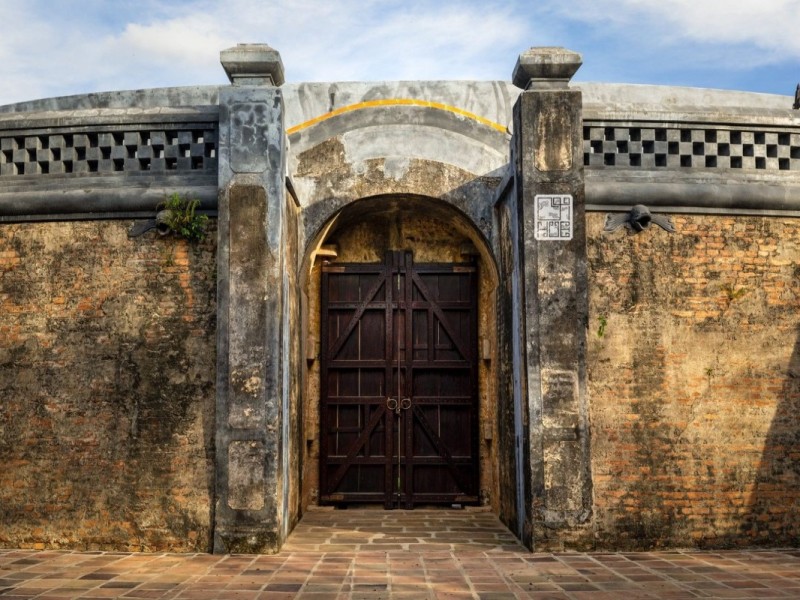
The Origins and Construction of the Arena:
Constructed during Emperor Minh Mang’s reign, the Tiger Arena was meticulously designed with the safety of the royal spectators in mind. Its unique circular design, featuring towering walls and reinforced with stone and brick, ensured that no tiger would escape and that the emperor could witness the event from a safe distance. The arena’s architecture was emblematic of the Nguyễn dynasty’s focus on grandeur and imperial might.
The circular structure allowed for unobstructed views for all attending dignitaries, while the strategic placement of inner cages ensured the tigers were securely confined until the battles began. This attention to detail and architectural ingenuity reflect the dynasty's prioritization of royal prestige and control.
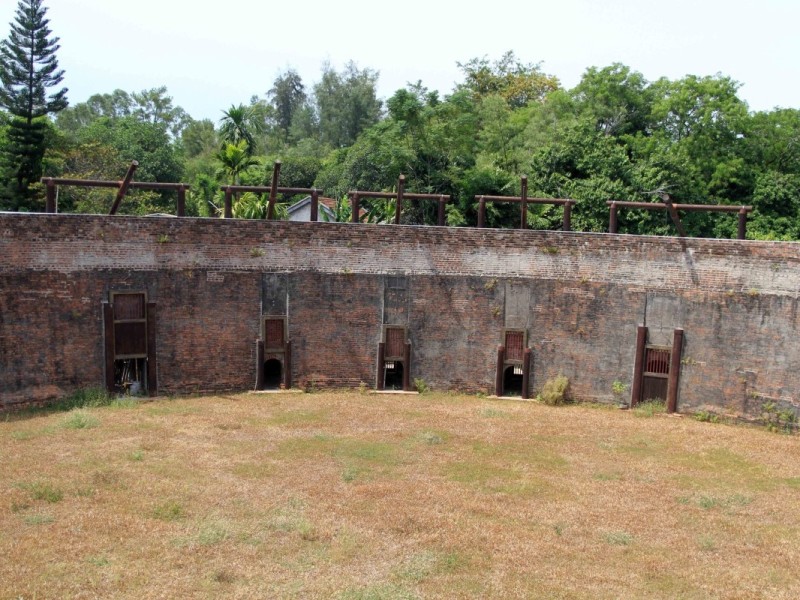
Comparison to Other Historic Arenas Worldwide:
While Hue’s Tiger Arena may not have the global recognition of the Roman Colosseum, it holds a unique place in the world’s history of arenas. Unlike the gladiator fights in ancient Rome, the elephant-tiger battles in Hue were symbolic displays of royal power. The arena was smaller in scale but no less significant in its cultural and historical context.
Whereas the Colosseum represented a spectacle of human combat, Hue’s Tiger Arena highlighted the emperor’s divine right to rule over nature. The arena also shares similarities with arenas in Asia, such as those used in ancient India for similar animal combats, yet remains unique in its representation of royal might.
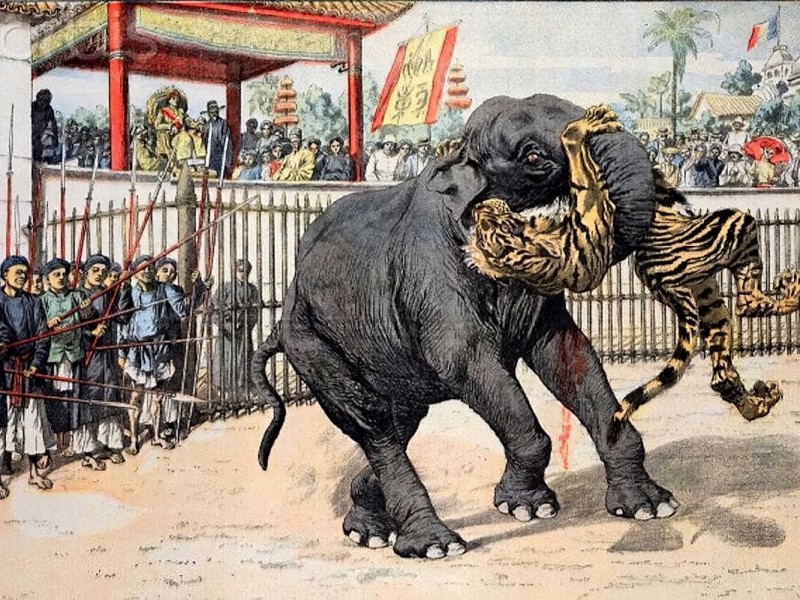
The Rise of Elephant-Tiger Battles as Royal Entertainment:
Elephant-tiger battles were deeply rooted in the traditions of the Nguyễn dynasty and became a key element of royal entertainment. These events were not just violent spectacles but carefully staged demonstrations of the emperor’s absolute power. Every battle was a metaphor for the emperor’s ability to conquer forces of rebellion, symbolized by the tigers, while the elephants represented strength, loyalty, and wisdom.

Origins and Purpose of the Royal Battles:
The elephant-tiger battles were first introduced as a way to showcase the emperor’s dominance over rebellious forces. Tigers, seen as dangerous and unpredictable, symbolized threats to the empire. The emperor’s war elephants, however, were carefully trained and symbolized stability and order.
These annual battles were intended to demonstrate that, just as the tigers were subdued by the elephants, any potential uprisings or threats to the emperor’s reign would be swiftly crushed. This tradition not only entertained the imperial court but also sent a powerful message to the people.
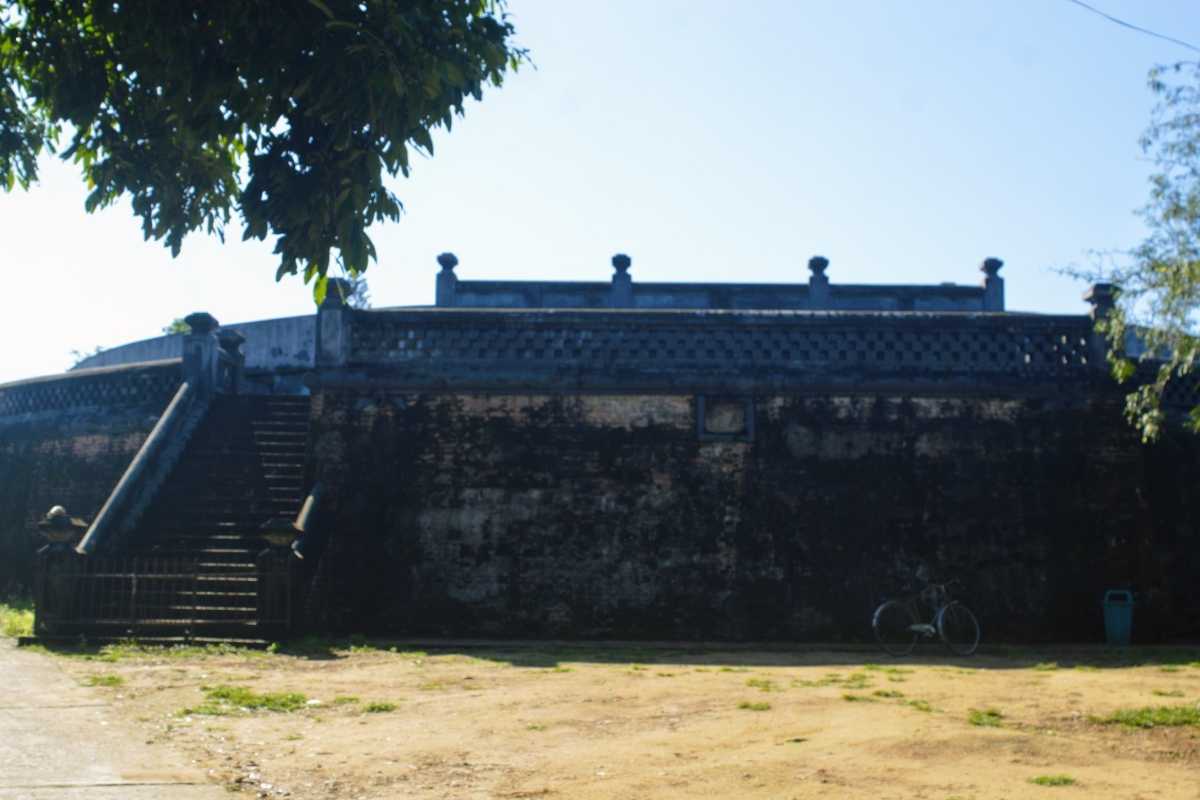
Spectacle for the Imperial Court and Public:
These battles were not confined to the royal family alone; they were public spectacles that drew large crowds from across the empire. Attendees would gather to witness these grand displays, cheering for the elephants as they overpowered the tigers. The emperor’s presence at these events further solidified his role as the divine ruler of the land.
The spectacle also served to strengthen the loyalty of the people to the emperor, as they watched his forces triumph over the wild and chaotic forces of nature. The arena’s design allowed for a large audience, creating a communal experience that reinforced the emperor’s authority.

The Last Battle: End of a Royal Tradition:
The tradition of elephant-tiger battles came to an end in 1904, as modernity began to take root in Vietnam. The last recorded battle was seen as a turning point, marking the end of an era of royal dominance and the beginning of Vietnam’s transition into a more modern political structure.
This final battle is remembered as a symbolic close to centuries of royal traditions, leaving the arena as a monument to the grandeur of the past. Today, it stands as a reminder of a time when royal power was celebrated through grand displays of animal combat.

Exploring the Architecture and Design of Hue’s Tiger Arena:
The architectural design of Hue’s Tiger Arena stands as a testament to the ingenuity of the Nguyễn dynasty, blending both functionality and grandeur. This arena, built in 1830, was meticulously designed with safety and spectacle in mind. The circular layout allowed the emperor and the court to view the battles from an elevated and secure vantage point, while the tigers were confined to inner cages until they were released into the arena. Every detail of the arena's design serves to highlight the imperial focus on control, power, and the dramatic visual impact of these royal displays. For visitors today, the Tiger Arena offers a rare opportunity to step back into history and witness the architectural brilliance of Vietnam’s imperial past.
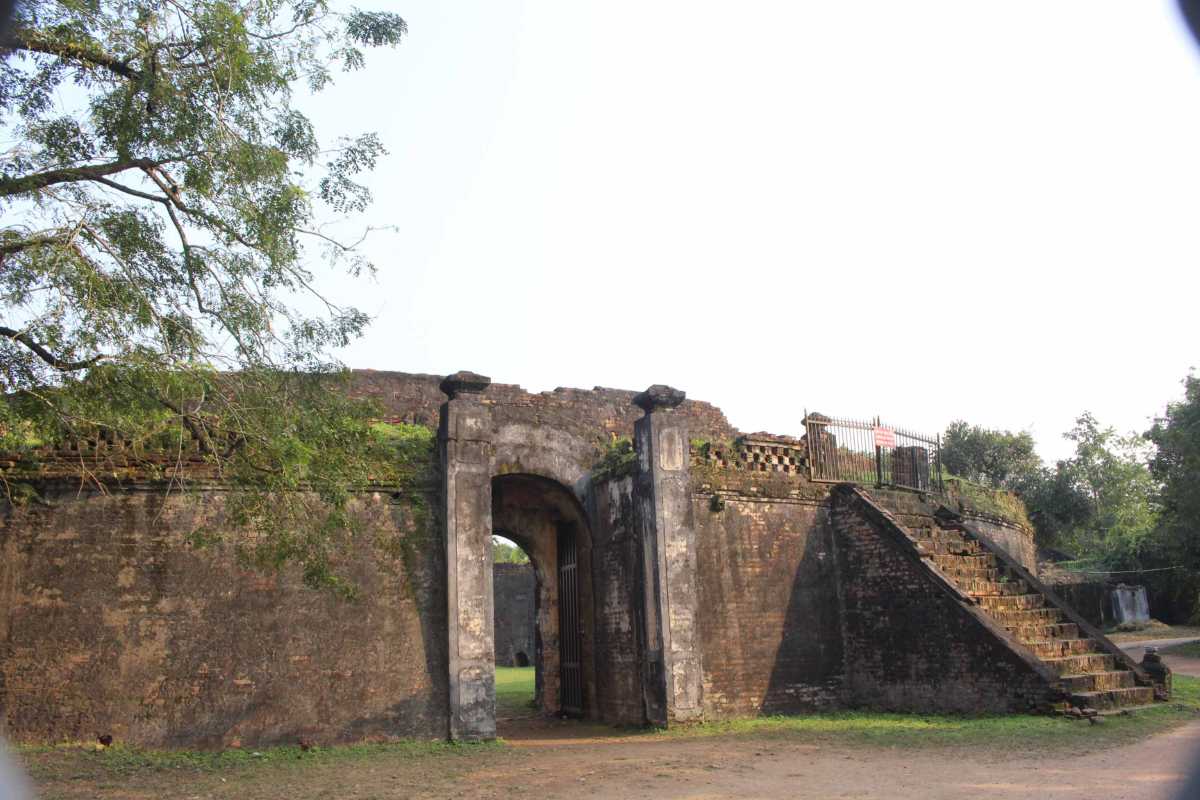
Unique Circular Design of the Arena:
The circular design of Hue’s Tiger Arena was not only an architectural innovation of its time but also a practical solution for ensuring the safety of both the royal family and spectators. With towering walls made of stone and brick, the arena formed an imposing structure designed to confine the wild tigers while still providing clear views of the spectacle from all sides. The circular structure allowed for a continuous flow of motion during the battles, making the confrontations between elephants and tigers all the more dramatic and visually striking.
The Nguyễn dynasty architecture is well known for incorporating traditional elements of Vietnamese construction with influences from Chinese and French styles, and the Tiger Arena is no exception. The use of durable materials ensured the longevity of the structure, while the layout facilitated an immersive experience for the court and public. Today, the circular design stands as one of the key features that make this arena such a fascinating historical landmark.
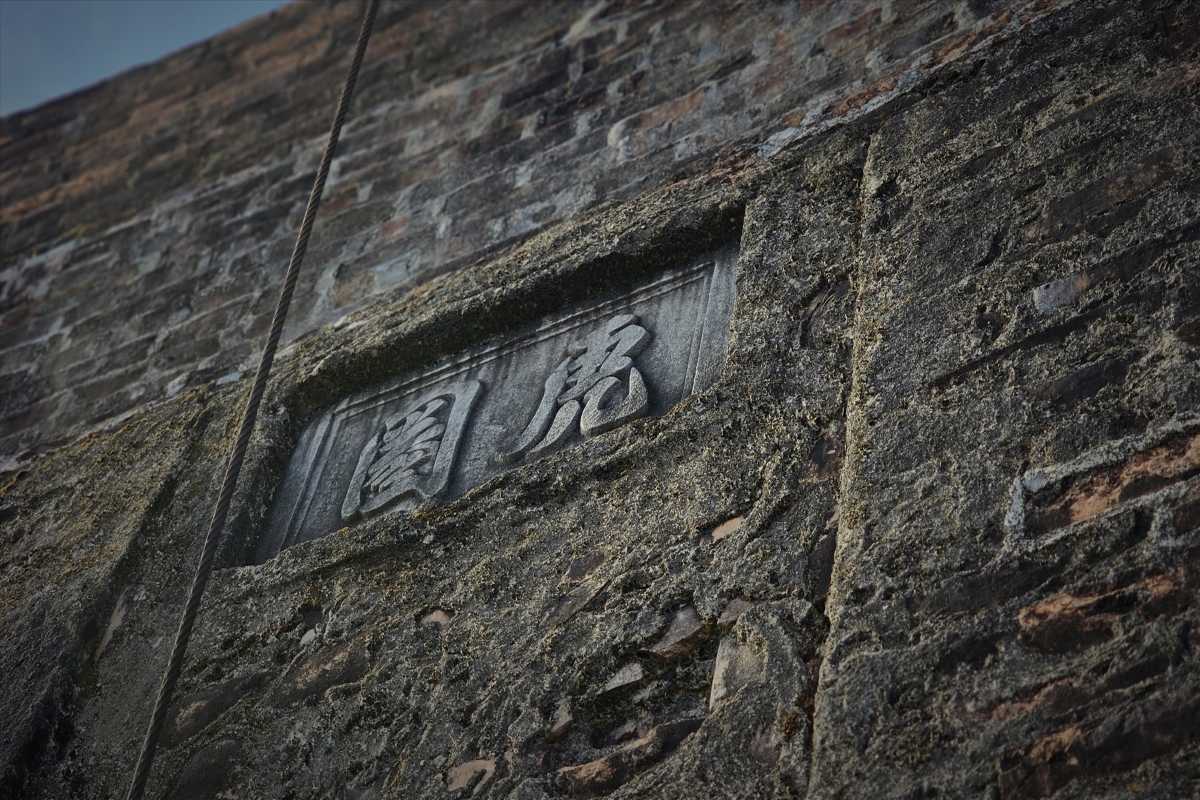
Cultural Legacy of the Battles: From Past to Present:
The elephant-tiger battles held at Hue’s Tiger Arena had far-reaching impacts on local traditions and festivals, many of which continue to this day. The battles were much more than mere spectacles; they were deeply embedded in the culture and rituals of the Nguyễn dynasty. The annual event marked a significant royal ceremony, symbolizing the emperor’s divine authority over nature and his control over rebellious forces, represented by the tigers.
Even though the battles have long since ceased, the legacy of these events lives on in the form of cultural festivals and traditions that are still celebrated in Hue and nearby regions. Festivals such as Hue’s cultural festivals often include re-enactments, storytelling, and community gatherings that recall the grandeur of these imperial battles. This connection between past and present highlights how the arena continues to influence the region’s cultural identity.
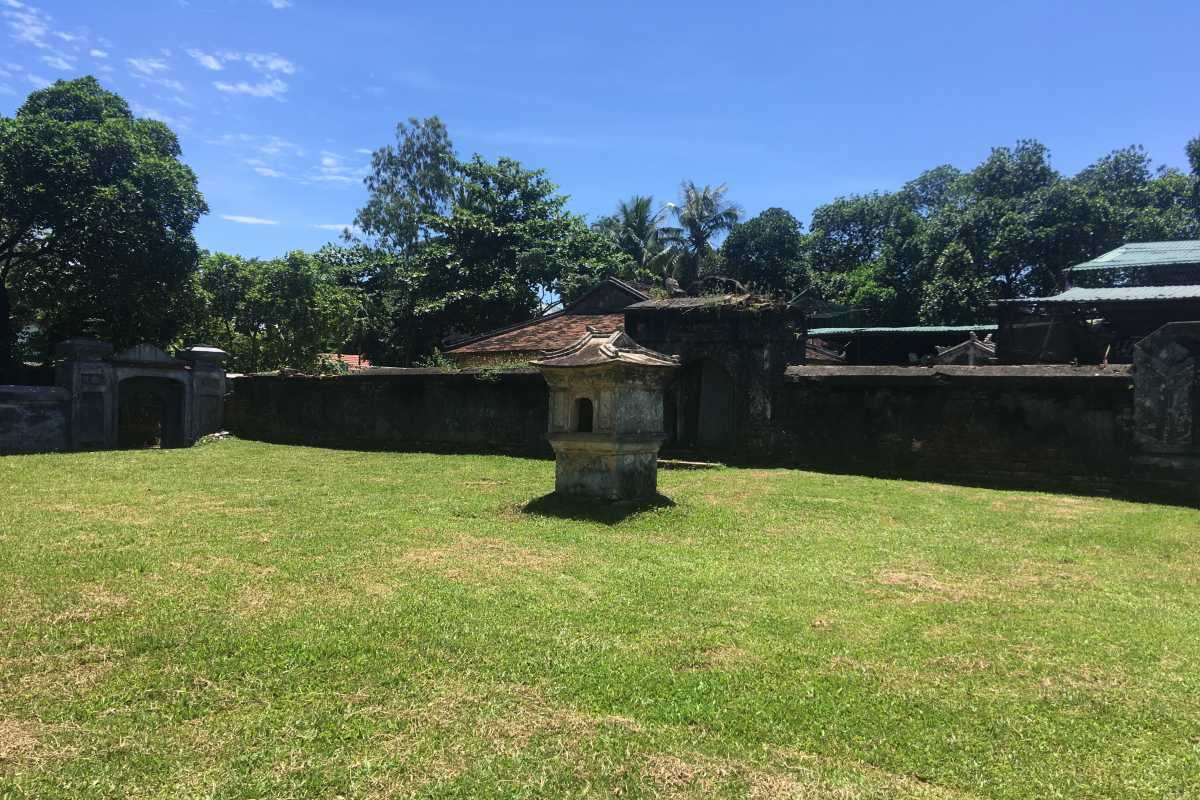
Preservation of the Tiger Arena Today:
Despite being nearly two centuries old, Hue’s Tiger Arena has been remarkably well-preserved. The structure’s durability is a testament to the craftsmanship of the Nguyễn dynasty, whose architects ensured that the arena would withstand the test of time. Visitors today can walk the same grounds where emperors once presided over fierce battles, with much of the arena still intact, including the towering walls and inner cages where the tigers were held.
Ongoing preservation efforts have helped maintain the arena’s historical integrity, ensuring that future generations can experience this unique site firsthand. The Tiger Arena stands as one of the most significant historical landmarks in Vietnam, offering a window into the past and a chance for visitors to engage with an important part of the country’s cultural heritage.
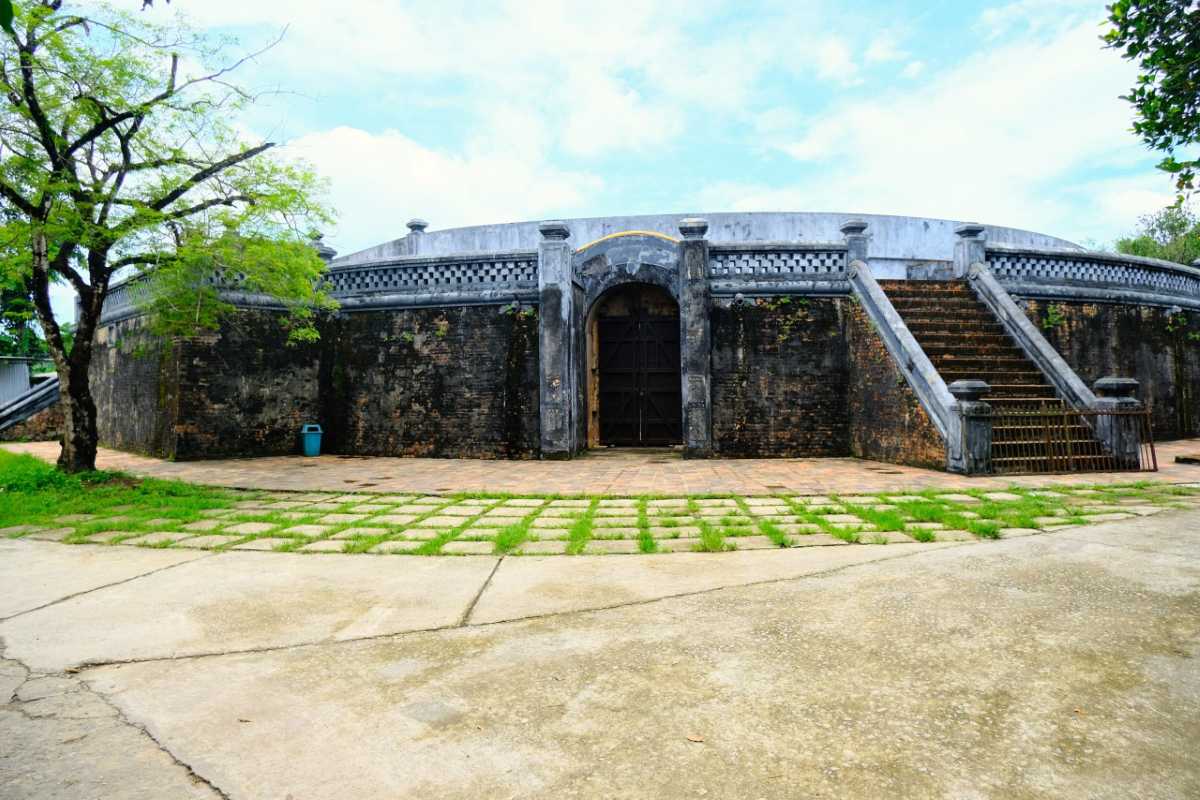
Delve into the Cultural and Historical Significance of Elephant vs Tiger Battles:
The elephant-tiger battles at Hue’s Tiger Arena were not simply violent confrontations but highly symbolic events deeply rooted in Vietnamese tradition. These battles were orchestrated to showcase the emperor's ability to maintain control over dangerous forces, with the elephant symbolizing loyalty, strength, and order, while the tiger represented chaos and rebellion. Each battle was a metaphor for the emperor's power and his divine right to rule, as the mighty elephants would triumph over the wild tigers.
The significance of these battles extended far beyond the arena, influencing Vietnamese royal ceremonies and reinforcing the emperor's authority among both the royal court and the general population.
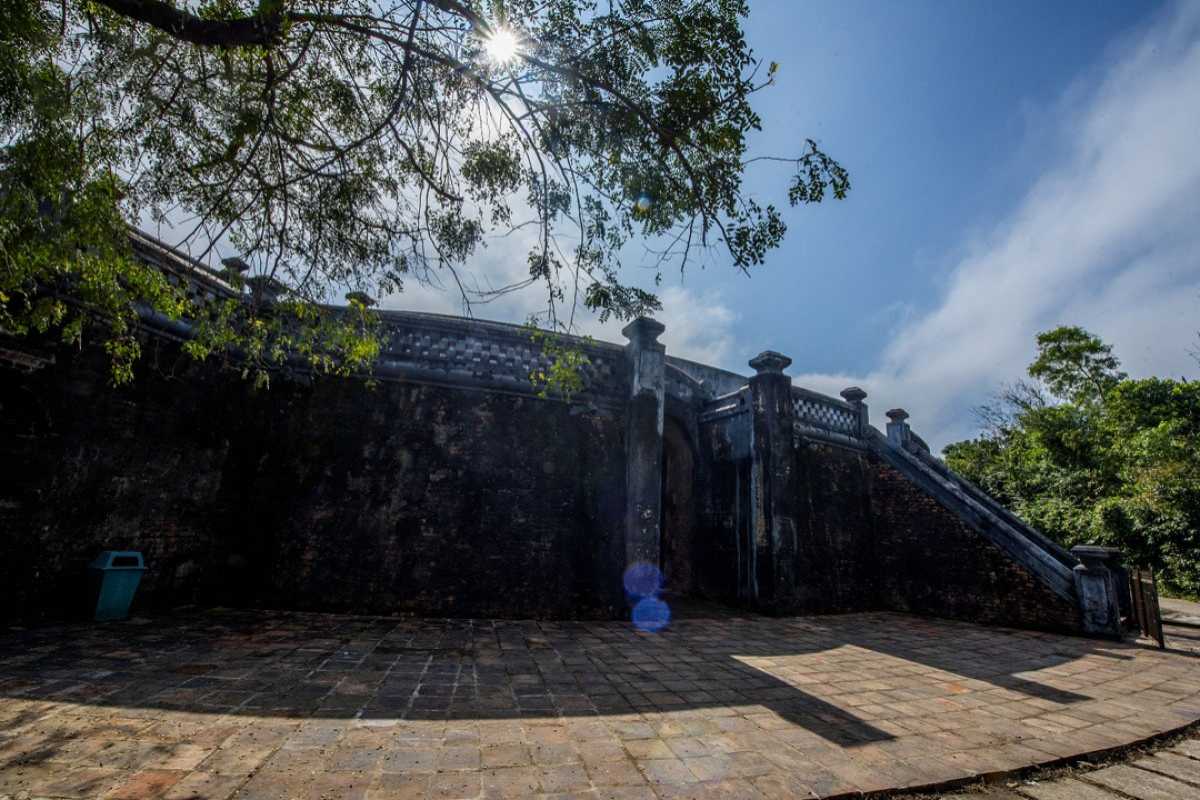
The Symbolism of Elephants and Tigers in Vietnamese Tradition:
In Vietnamese tradition, the elephant has always been a symbol of strength, wisdom, and loyalty. Historically, elephants were considered sacred animals, often used in royal processions and military campaigns, symbolizing the emperor’s protection over his people. The tiger, on the other hand, was viewed as a rebellious and dangerous force, embodying wild, untamed energy.
The battles between elephants and tigers were staged as a dramatic representation of the emperor's ability to maintain peace and order in the kingdom by subduing the wild, untamed forces of rebellion. These battles reflected the duality of control versus chaos and reinforced the emperor’s divine mandate to rule. The symbolism behind these events continues to resonate in Vietnamese royal battles, making the Tiger Arena a site of profound cultural significance.
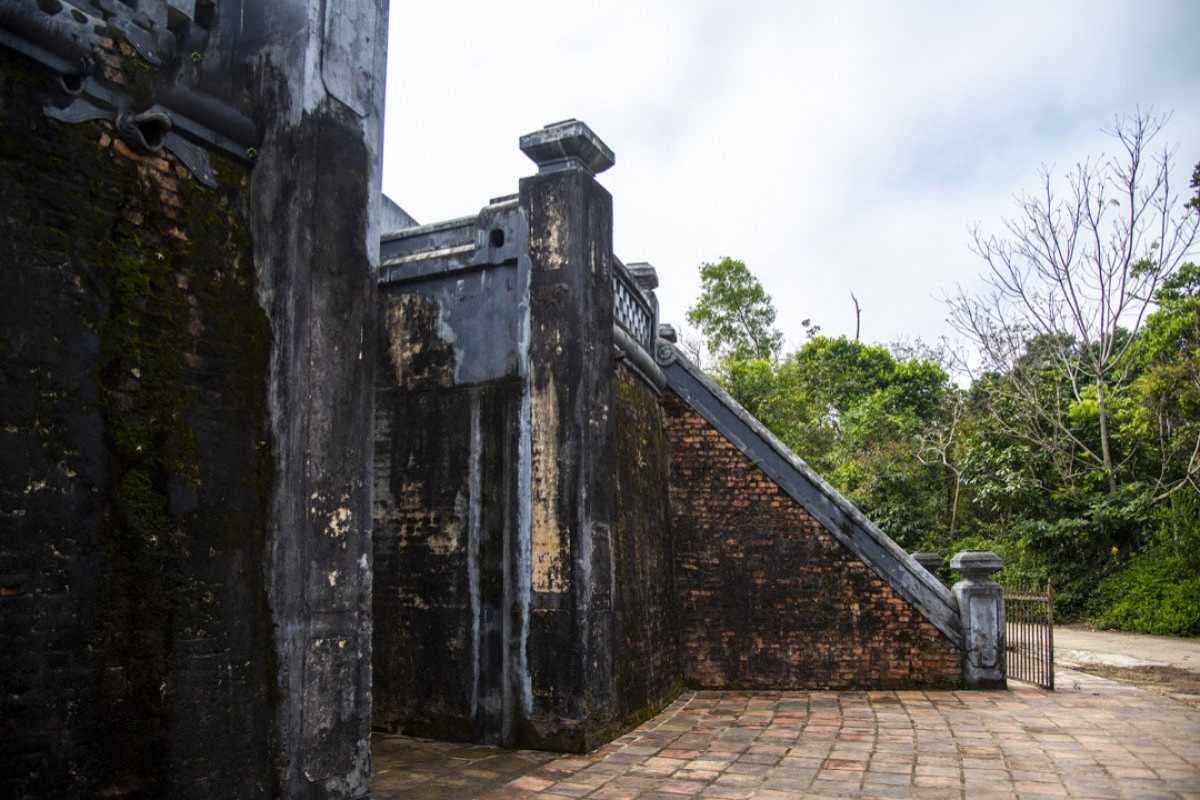
The Annual Royal Event: A Cultural Phenomenon:
The elephant-tiger battles were not isolated events but an essential part of the annual royal ceremonies. These ceremonies were significant cultural phenomena, drawing attendees from across the empire to witness the emperor’s power firsthand. The battles were often accompanied by elaborate processions, musical performances, and displays of wealth and grandeur, all designed to emphasize the emperor's dominance.
These events became a symbol of the strength of the empire, as the emperor’s ability to subdue the rebellious tigers served as a public display of his military and political power. The annual nature of these events ensured that they remained a central part of the cultural landscape during the Nguyễn dynasty, solidifying the Tiger Arena as a key location for cultural events in Hue.

First-Hand Accounts of the Spectacles:
Historical records and travelogues from visitors who attended the elephant-tiger battles provide vivid descriptions of the spectacles that took place at Hue’s Tiger Arena. These first-hand accounts highlight the intensity of the battles, the grandeur of the emperor’s presence, and the emotional reactions of the crowd. Accounts from royal dignitaries and foreign diplomats offer a detailed view of the rituals surrounding the battles, from the moment the tigers were released into the arena to the triumphant display of the emperor’s elephants overpowering their foes.
Many of these records also reveal the dramatic tension that filled the air during the battles, with the roaring of the crowd and the intense focus of the emperor. These historical accounts provide invaluable insights into the pageantry and symbolism of these events, helping modern-day visitors imagine the atmosphere of the arena centuries ago.

Why You Should Visit Hue’s Tiger Arena Today:
A visit to Hue’s Tiger Arena offers much more than just a glimpse into Vietnam’s history; it provides a deeply immersive and unique cultural experience. Few sites in the world can offer the same connection to royal traditions, where historical events and the symbols of power were played out before the emperor and his court. For those seeking a genuine connection to Vietnam's rich cultural past, Hue’s Tiger Arena stands out as a must-visit destination. As one of the rare surviving arenas of its kind, it gives travelers the opportunity to explore the country’s imperial legacy in a way that is tangible, emotional, and deeply inspiring.
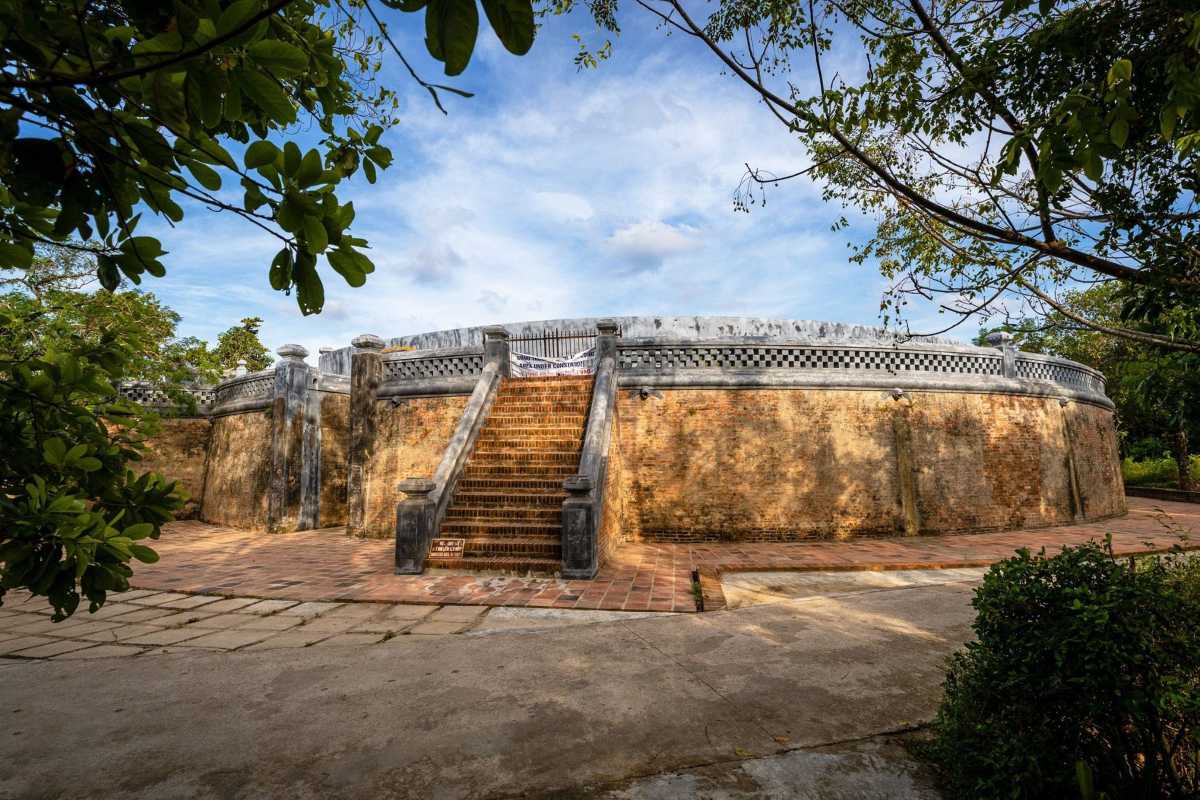
A Rare Cultural Experience:
Hue’s Tiger Arena is not just a historical site; it is a portal to the past where visitors can witness the grandeur of the Nguyễn dynasty. Unlike the more famous landmarks that attract large crowds, this arena offers a more intimate and reflective experience, allowing visitors to engage closely with a key part of Vietnam’s royal history. Standing in the same place where emperors watched fierce battles unfold, visitors can feel the weight of history and understand the significance these events held for the people of the time.
As one of the rare cultural landmarks in Vietnam, the arena offers an unmatched experience that provides deep insights into the traditions and power dynamics of the era. Whether you are a history enthusiast, a cultural explorer, or a curious traveler, this site provides one of the best experiences in Hue.
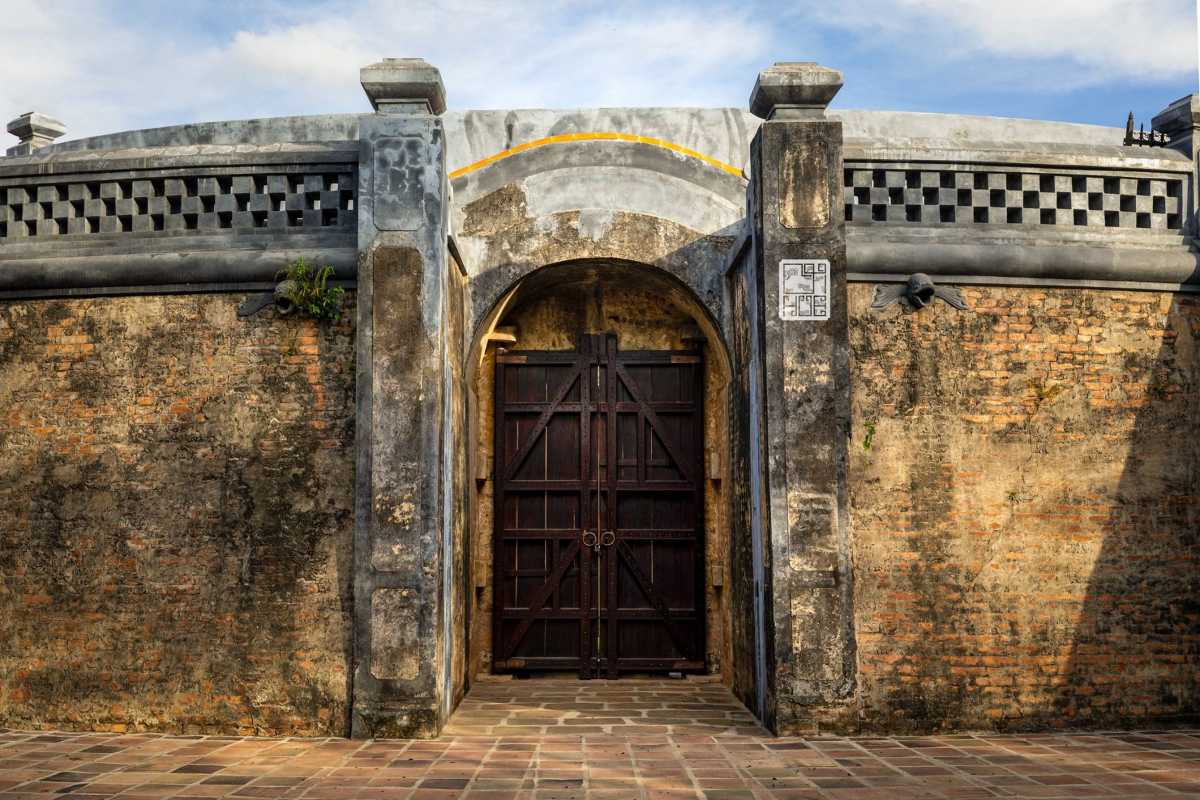
Emotional Connection to Vietnam’s Royal Past:
Visiting Hue’s Tiger Arena is not just about seeing an ancient structure; it is about making a profound emotional connection with Vietnam’s royal heritage. Standing in the center of the arena, visitors can imagine the cheers of the crowd, the powerful presence of the emperor, and the dramatic confrontations between elephants and tigers. This emotional journey allows travelers to step back in time and feel the weight of history in a way that few other destinations offer.
The emotional pull of Vietnam’s royal heritage is tangible in every corner of the arena. For many visitors, the site evokes a deep sense of connection to the past, allowing them to experience firsthand the traditions and ceremonies that once symbolized the emperor’s strength and the kingdom’s unity.

What Past Visitors Have Said About Hue’s Tiger Arena:
Many travelers who have visited Hue’s Tiger Arena leave with lasting memories and a strong emotional connection to the site. Past visitor testimonials often highlight the deeply immersive nature of the experience and the rare opportunity to engage with such a well-preserved historical landmark. Tour guides, historians, and local experts often bring the arena’s history to life with vivid stories, adding depth to the visit and leaving visitors with a renewed appreciation for Vietnam’s imperial past.
One visitor remarked, “Standing in the arena was like stepping back into history. The grandeur of the past was palpable, and the stories from our guide made it even more meaningful.” Such experiences make Hue’s Tiger Arena a truly memorable destination for anyone interested in the region’s history.
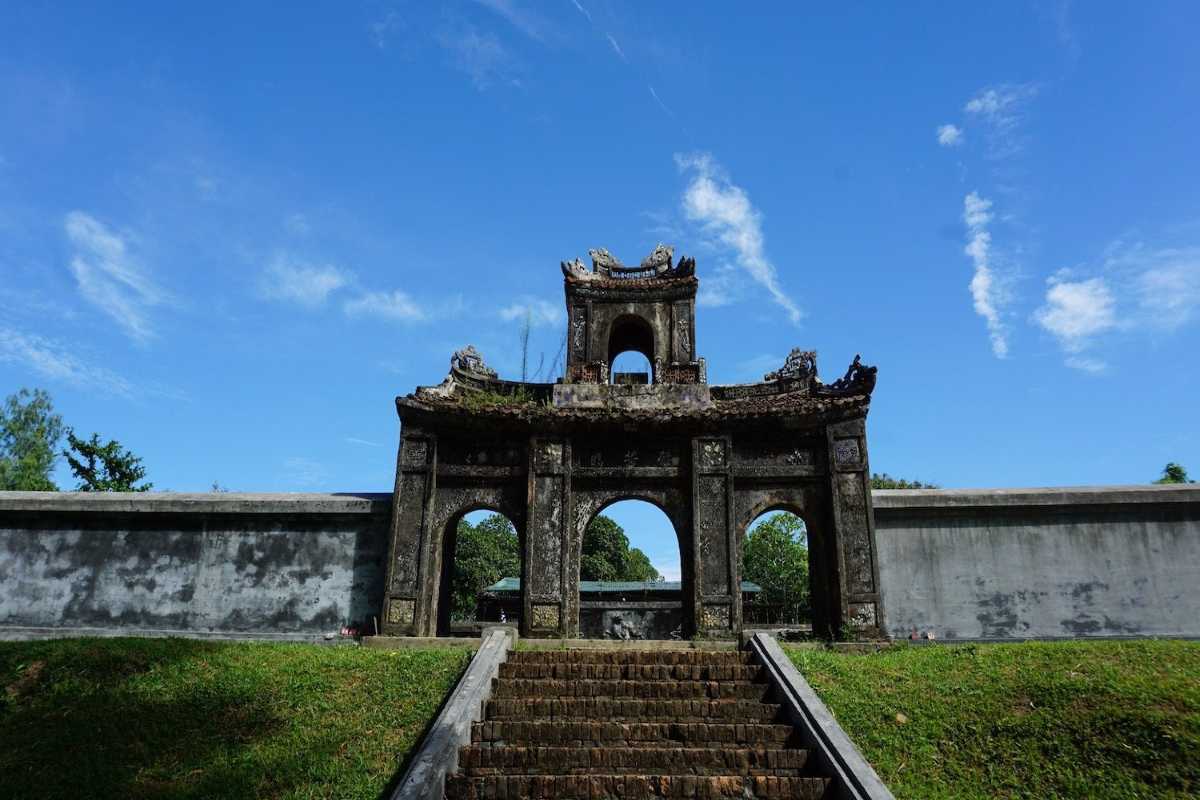
Practical Reasons for Exploring Hue’s Historical Landmarks:
Beyond the emotional and cultural significance, there are many practical reasons to explore Hue’s historical landmarks. The city of Hue itself is a treasure trove of Vietnam’s royal history, and the Tiger Arena is just one of many sites that offer a glimpse into the past. By visiting these landmarks, travelers can gain a comprehensive understanding of Vietnam’s imperial history, while also enjoying a range of immersive experiences that bring the country’s rich cultural traditions to life.
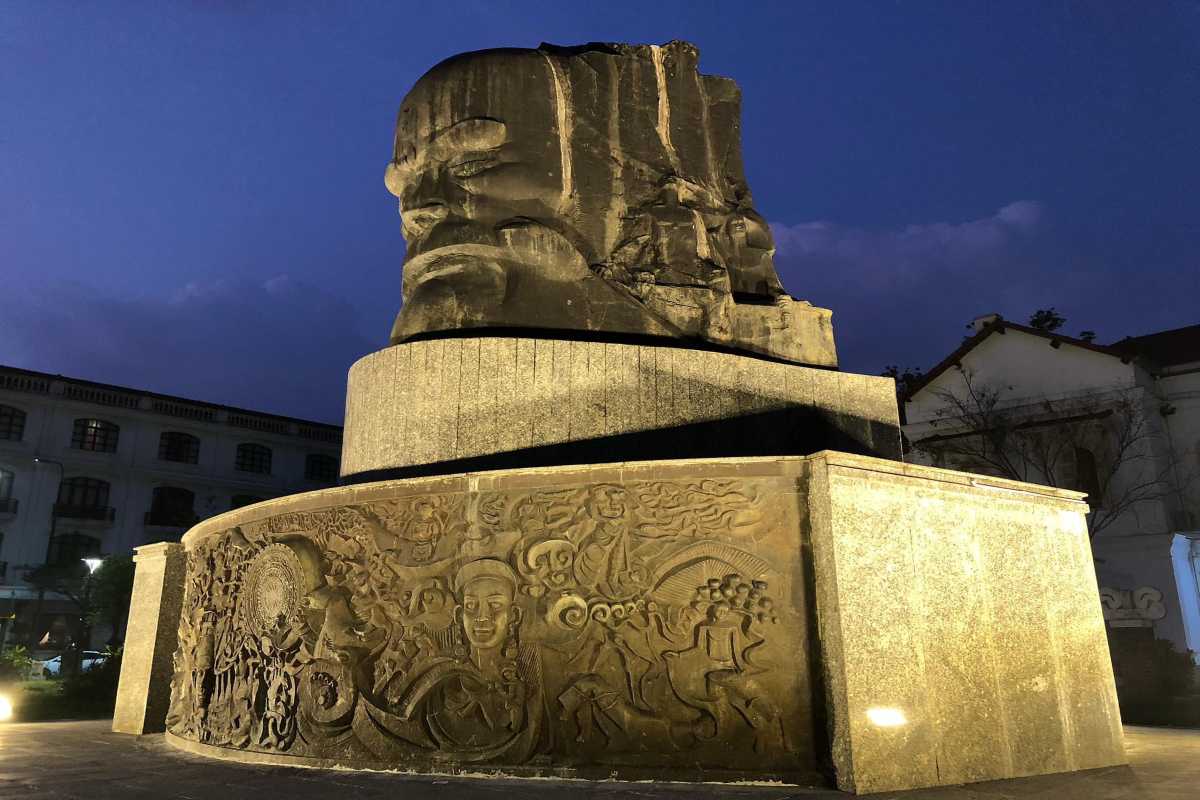
Guided Tours and Immersive Experiences:
One of the best ways to experience Hue’s Tiger Arena is through a guided tour. Knowledgeable tour guides offer detailed explanations of the arena’s history, architecture, and cultural significance, allowing visitors to fully immerse themselves in the experience. Guided tours also provide additional context about the Nguyễn dynasty and the significance of the elephant-tiger battles, making the visit more meaningful and educational.
For those seeking a deeper connection to the history of the site, guided tours in Hue provide invaluable insights and personal stories that highlight the arena’s role in Vietnam’s royal past. These immersive cultural experiences allow visitors to engage with history in a way that books and online resources simply cannot match.

Immersive Cultural Tours of Hue’s Tiger Arena:
In addition to individual visits, cultural tours that include Hue’s Tiger Arena and nearby historical sites offer an enriching journey through the city’s royal heritage. These tours often provide a more comprehensive experience by connecting the stories of multiple landmarks, allowing visitors to see how the arena fits into the broader narrative of Hue’s royal history.
By participating in an immersive tour, travelers can explore not only the arena but also other key landmarks like the Imperial City, deepening their understanding of Vietnam’s rich history. These tours often include expert commentary, historical re-enactments, and detailed narratives that bring the past to life, making them ideal for anyone interested in both history and culture.

Nearby Attractions to Complement Your Visit:
Hue’s Tiger Arena is conveniently located near several other significant historical landmarks, making it easy to plan a full day of exploration. After visiting the arena, travelers can explore the nearby Imperial City, Thien Mu Pagoda, or Tomb of Emperor Tu Duc, each of which offers its own unique insights into Vietnam’s royal past.
For those interested in fully immersing themselves in Hue’s historical landmarks, the proximity of these sites allows for a seamless transition from one attraction to the next, ensuring that visitors leave with a well-rounded understanding of the city’s cultural heritage. The ease of access and the rich history of each site make Hue a prime destination for history enthusiasts.
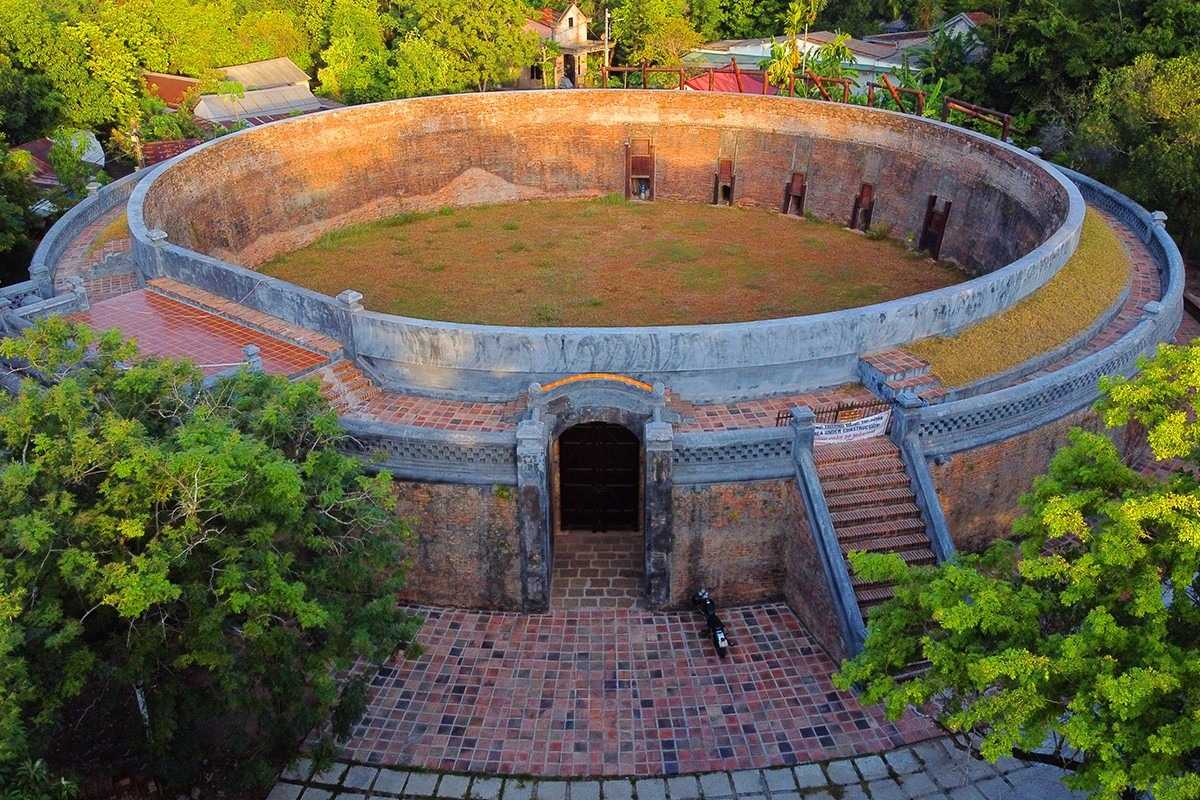
Plan Your Visit to Hue’s Tiger Arena Now:
Planning a visit to Hue’s Tiger Arena is the perfect way to immerse yourself in Vietnam’s rich royal history and explore a rare cultural site that few tourists get to experience. Located just minutes from Hue’s city center, the arena is easily accessible and offers an in-depth look at a significant chapter of the Nguyễn dynasty. Whether you’re traveling alone, with family, or in a group, visiting this historic site provides a memorable and educational experience for everyone. To make the most of your visit, it’s best to plan ahead, considering tour options, transportation, and practical tips for an enriching experience.

How to Get There and What to Expect:
Reaching Hue’s Tiger Arena is straightforward, with several convenient transportation options available. Visitors can easily access the site by car, taxi, or bicycle from the city center. For those looking to enjoy the scenic route, cycling is a great way to take in the sights of Hue’s historical landmarks along the way. The arena itself is well-preserved and offers a glimpse into Vietnam’s imperial past, with informative plaques and guided tours available to provide context about the arena’s historical significance.
When you arrive, you’ll be greeted by the towering stone walls of the arena, which have stood the test of time, allowing visitors to step back into history. Guided tours are highly recommended, as they provide fascinating insights into the royal elephant-tiger battles that took place here, offering a deeper understanding of Vietnam’s imperial culture.

Best Tour Companies for Hue’s Historical Sites:
Several top-rated tour companies offer immersive guided tours of Hue’s Tiger Arena and other important historical landmarks in the area. These companies provide visitors with an enriching cultural and historical experience, making sure they don’t miss any of the essential details that make the arena so special. Some tours include additional stops at nearby landmarks, such as the Imperial City and Thien Mu Pagoda, creating a comprehensive exploration of Hue’s royal history.
When choosing a tour, consider factors such as duration, group size, and whether the guide has extensive knowledge of the Nguyễn dynasty and Hue’s historical sites. Many tours offer flexible options, including private or small group experiences, which can enhance your visit by allowing for more in-depth discussions and personalized recommendations.

Practical Tips for Visiting the Tiger Arena:
To fully enjoy your visit to Hue’s Tiger Arena, consider these practical tips to ensure a smooth and enjoyable experience. The best time to visit Hue is between October and March, when the weather is cooler and ideal for exploring outdoor historical sites. It’s also a good idea to plan your visit during the weekdays to avoid larger crowds that tend to gather on weekends.
Dress comfortably, as you’ll be walking through the arena and possibly visiting other nearby landmarks. Wear light clothing and comfortable shoes, especially during warmer months. If you’re interested in photography, the late afternoon provides the best lighting for capturing the grandeur of the arena’s architecture. Lastly, don’t forget to bring water, sunscreen, and a hat to stay hydrated and protected from the sun.

Summarizing Hue’s Tiger Arena and Its Importance:
Hue’s Tiger Arena offers visitors a rare and profound connection to Vietnam’s royal past, allowing them to explore a site where emperors once ruled and historical battles took place. This blend of cultural history, architectural significance, and royal spectacle makes the arena one of Hue’s hidden gems. From its unique design to the dramatic stories of the elephant-tiger battles, the arena provides a glimpse into the power and tradition of the Nguyễn dynasty. Visiting this site is an opportunity to connect with Vietnam’s history in a way that few other landmarks can offer, making it a must-see destination for anyone interested in the country’s rich heritage.

Plan Your Visit Now:
Don’t miss the chance to experience one of Hue’s most unique cultural landmarks. Hue’s Tiger Arena invites you to explore its history, immerse yourself in the traditions of the Nguyễn dynasty, and witness the grandeur of this well-preserved royal site. Whether you’re a history enthusiast, a cultural explorer, or simply curious about Vietnam’s past, this arena offers an unforgettable experience. Book your tour today and take the first step toward discovering a key part of Vietnam’s royal legacy.
Nhật Hoàng
Faqs
Hue’s Tiger Arena is a rare royal monument where the Nguyễn dynasty staged elephant-tiger battles to showcase imperial power. This arena is unique in Vietnam’s history for its dramatic events and symbolic meaning.
- Built in 1830 during the reign of Emperor Minh Mang
- Hosted spectacular battles between elephants and tigers
- Served as a symbol of royal strength and control
- One of the few arenas of its kind in Asia
Visiting this site allows you to experience an authentic piece of Vietnam’s royal heritage.
You can reach Hue’s Tiger Arena from the city center easily by car, taxi, bicycle, or motorbike. The site is about 5 kilometers southwest of the Imperial City.
- Take Bui Thi Xuan Street towards Thuy Bieu Ward
- Follow signs for Tiger Arena or ask locals for "Ho Quyen"
- Travel time is around 10 to 15 minutes by car or taxi
- Cycling is possible for active travelers
Plan your route in advance for a smooth visit to this historical landmark.
Currently, there is no official entry fee to visit Hue’s Tiger Arena. The site is open to the public, making it accessible to all travelers.
- Free entrance for individuals and groups
- Occasionally, donations may be encouraged for maintenance
- Fees may change if restoration projects occur
Check locally for updates before your trip to ensure the latest information.
Hue’s Tiger Arena is typically open during daylight hours, as it is an outdoor site with no official gate or ticket booth.
- Open from early morning until sunset
- Best visited between 7:00 AM and 5:30 PM
- Access may be limited during major restoration or special events
It’s wise to visit during daylight for safety and a better experience.


